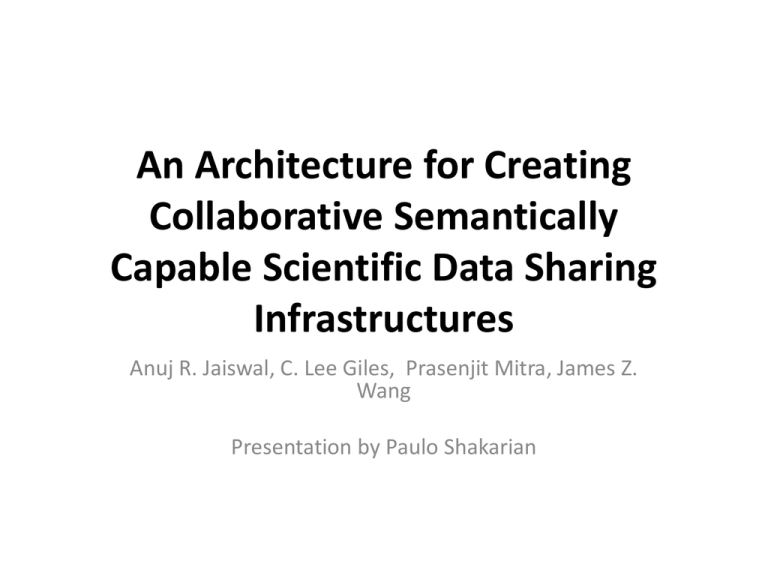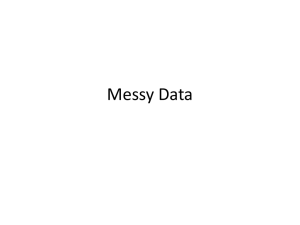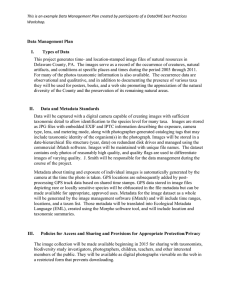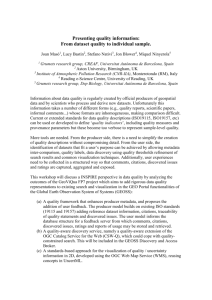An Architecture for C reating Collaborative Semantically_Paulo_Shakarian.pptx
advertisement

An Architecture for Creating Collaborative Semantically Capable Scientific Data Sharing Infrastructures Anuj R. Jaiswal, C. Lee Giles, Prasenjit Mitra, James Z. Wang Presentation by Paulo Shakarian Outline • • • • • • • Problem Overall Goal Contributions Metadata Implementation Future Work Comparison to SIBDATA Concept Problem • Researchers often reference experimental results of their predecessors • However, the raw data of experimental results is often not readily available. – Hence, results often cannot easily be re-used or combined with other experiments Problem (cont.) • Large repositories (i.e. NASA, NOAA, etc.) do collect experimental data – Often conform to global schema (which may cause some data to be lost) – Or stored as flat-files (requiring custom-built query applications) • Also, data labels in experiments may differ (i.e. Temp. vs. Temperature vs. Celsius) Overall Goal • Architecture for dissemination, sharing, querying, and searching of scientific data on the WWW • Schema not known a-priori • Approach relies on sufficient meta-data of two varieties: – Data about the experiment (conditions, source, when uploaded, etc.) – Semantics for columns/rows in experimental results (what they represent, what units, etc.) Overall Goal (cont.) • Two-part approach: – Annotation application for semiautomatic creation of annotations – Web-portal for searchable storage of annotated scientific data. Contributions of the Paper • Propose architecture for semantically capable collaborative infrastructure for data collection and sharing • System that utilizes two-level metadata scheme for document description and dataset attributes • Description of current implementation Dataset Metadata • Dublin Core (http://dublincore.org) is a set of 15 elements for minimal resource description to ensure minimal operability – OAI-PMH – IETF RFC 5013 – ANSI/NISO Standard Z39.85-2007 – ISO Standard 15836:2009 • Attributes listed on next 3 slides Dataset Metadata • Paper states “uses Dublin Core 15 elements” but actually uses the following 15: – – – – – – Title Creator Subject Description Contributor Publisher – – – – – – Date Type Format Identifier Source Relation – References – Is referenced by – Language – Rights – Coverage. Attribute Metadata • Challenges: – Same attribute, different row/column name – (i.e. Temp vs Temperature – Same row/column name, but different attribute (i.e. Temperature (in deg C) vs Temperature (in deg K) – Row/column names may be ambiguous (i.e. Rate) Attribute Metadata • Metadata tags for attributes (right) • Note they allow for dynamic generation of a dynamic collaboration ontology – – – – – Equivalent To Different From Superset Of Subset Of Type Of Submitting a Dataset • Uses a ``pull’’ technique – Author submits URL – System pulls annotated data • Pull method allows the following – A moderator can check the URL from non-authorized submitters – Automatic tagging of provenance information for authorized users based on URL – Better protection from DOS attacks • Banning of malicious users • Implement a round-robin policy for fetching Implementation: Metadata • Used for chemical kinetics experiments • Experimental results in MS Excel • Metadata added through a MS Excel add-in Implementation: Web Portal • Three components – Web portal front-end – Data downloader and parser – Data analysis toolkit Implementation: Web Portal • Web Portal Front-End – Content management system – Dataset viewer – Data submission system • Uses Mambo Server (open source, PHP-based) content-management system • Data submission system deployed using JSP on ApacheTomcat 5 Implementation: Web Portal • Data downloader and parser – Scheduler – Downloader – Parser • Parser – Creates metadata as XML files – Data in Excel files imported into MySQL database – Parser creates a dataset index, linking dataset with dataset metadata and attribute metadata with data tables Implementation: Data Analysis Tools • In addition to supporting queries, plotting and regression tools included in web portal Future Work • Develop algorithms to derive dynamic collaboration ontology's • Integrating query re-wrting and semantic searching using attribute-level semantics • Automatic metadata generation using a user’s previous experiments • Group, trust, privacy mechanisms Comparison to SIBDATA Concept • Relies on central repository (as opposed to multiple repositories for SIBDATA) • Only useful for Excel-formatted experimental results • Annotations may be an interesting feature to include in a SIBDATA or CDATA. Questions




